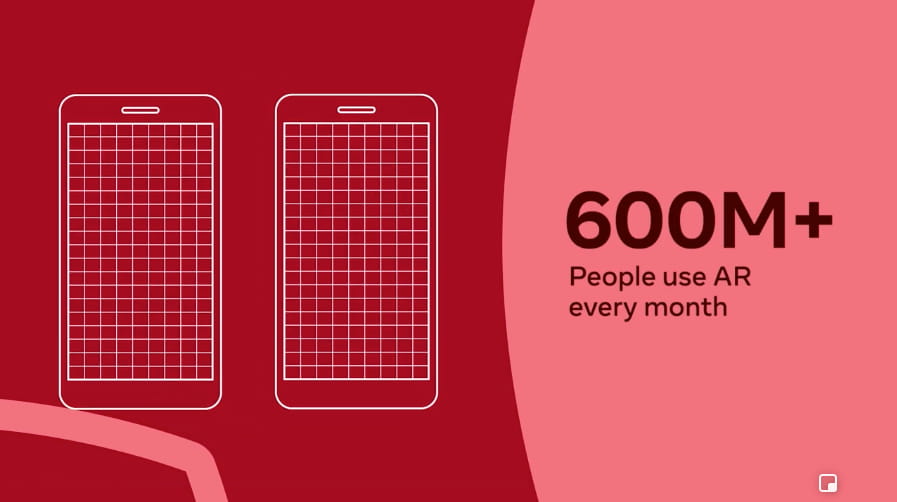
Last month, Facebook’s held a toned-down version of it’s annual F8 developer conference known as F8 Refresh. It included a handful of notable and incremental AR updates, such as multipeer AR face filters. These bring a syncronous multiplayer twist to social AR.
But buried in these updates was another notable data nugget that signals Facebook’s mobile AR growth trajectory. Specifically, more than 600 million people now use Facebook’s AR effects monthly. That happens across News Feed, Instagram, Messenger, and Portal.
It’s unclear how those 600 million people array across these properties but we know from past research that the most AR scale and frequency occurs on the flagship News Feed. However, Instagram’s younger AR developments have considerable promise (more on that in a bit).

Ratcheting Up
One question that arises from this milestone is how it stacks up to chief social AR rival, Snap. The latter has 200 million+ daily AR users or 71 percent of daily Snap users. If we apply that to its 500 million monthly users (the same metric Facebook uses), we get roughly 355 million AR users.
This clearly puts Facebook in the lead in active AR users, which is to be expected from its larger global reach of 2.8 billion total monthly actives. But in fairness to Snapchat, it has a greater share of its user base engaged with AR — again 71 percent compared to Facebook’s 21 percent.
As we examined recently, both players are neck-and-neck when it comes to lens volume. They both also continue to ratchet up efforts to attract lens creators to their platforms with new features. That’s the first step in the virtuous cycle of creation, engagement and monetization.
And for both players, all of the above elevates AR comfort levels, pursuant to the real endgame: AR glasses. Both Snap and Facebook have been forthright about their AR glasses plans. They’ve also been forthright that fully-actualized consumer AR could be a decade away.
But that doesn’t mean the path to that goal isn’t valuable in itself. Both companies are investing heavily in optimizing user experiences, comfort levels, and developer aptitude around spatial computing. And — in the case of mobile AR lenses — they’re making money along the way.
Is Ubiquitous AR a Decade Away?
Collision Course
Back to a point made earlier, one of Facebook’s mobile AR propellants is the mighty Instagram. News Feed and Messenger are fitting places for AR, but Instagram may be the real ace up its sleeve. Its 1 billion active camera-forward users are naturally aligned with AR.
To expand on that alignment, social sharing is core to Instagram which breeds AR lens virality, just like Snapchat. Instagram also continues to cultivate shoppable content. This makes eCommerce and AR — already natural bedfellows — on a collision course at Instagram.
Instagram is earlier in its AR lifecycle, so the above will play out similar to how it did at Snap and at Facebook’s other properties. This progression includes new AR formats, user acclimation, community lens creation, and monetization. The latter is where brands pay to distribute AR lenses.
So far, this has all unfolded to some degree as Instagram works with fashion retailers to integrate AR product try-ons as part of its in-app transaction features. These integrations are logical, as Instagram has become a place for consumers to discover products and transact.
Another factor is motivation: Facebook is driven to make all of this happen because its ad inventory growth is maturing on the flagship News Feed. Because that’s its core product, which it doesn’t want to oversaturate with ads, it’s looking to untapped ad inventory in other properties.
Facebook Connect: The AR Angle
Key Step
Altogether Facebook has several tracks for spatial computing, which will eventually converge. It has primary VR ambitions to connect the world in more immersive ways (and monetization therein); AR glasses, Live Maps and deep XR research; and nearer-term mobile AR lenses.
The latter may be the least sexy of the lot, but it’s a key step to get users and developers spatially acclimated. That will prime the next era of headworn experiences that Facebook is aiming for, as noted. But in the meantime, mobile AR is generating real traction and revenue today.

